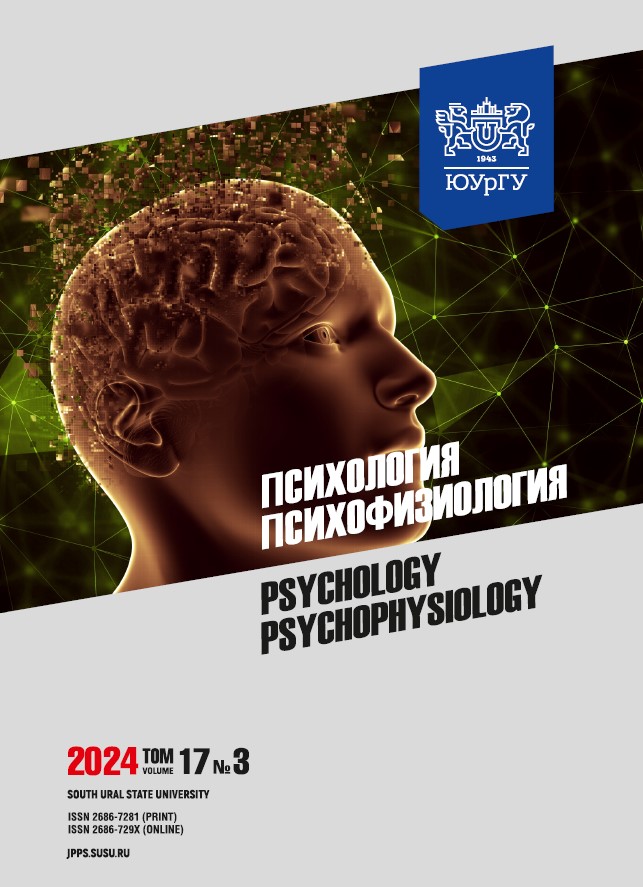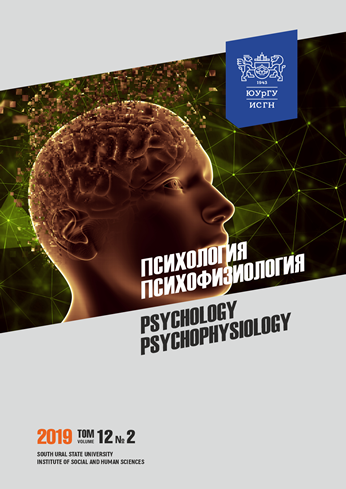Features of emotional intelligence and self-regulation of behavior in adolescent e-athletes with different levels of assertiveness
Abstract
Introduction. Modern society has witnessed a paradigmatic shift in the expectations placed upon adolescence, particularly when it comes to sporting activities. Esports presents a unique combination of psychophysiological measures and social skills. This study aims to elucidate the manifestations of emotional intelligence and behavioral self-regulation among adolescent athletes with different levels of assertiveness. Materials and methods. A sample of 57 schoolchildren (12.2 ± 1.1 years; esports experience 2.2 ± 0.8 years) underwent comprehensive psychodiagnostic assessments with a battery of tests, including the Sheinov Assertiveness Test, the Eyesenck Personality Inventory (as adapted by Shmelev), the Lyusin Emotional Intelligence Test, the Morosanova Self-Regulation Profile Questionnaire, and the Ilyn Personal Aggressiveness and Proneness to Conflict Test. Based on assertiveness test outcomes, adolescents were assigned into one of the three groups: “aggressive”, “assertive”, and “insecure”. Data analysis was performed by means of IBM SPSS Statistica v. 23, with Shapiro–Wilk, Kruskal–Wallis, and Mann–Whitney tests applied. Spearman correlation analysis evaluated relationships between studied parameters across compared groups.
Results. Across all levels of assertiveness, adolescent athletes exhibited high scores on scales measuring “Uncompromising attitude” and “Positive aggressiveness”. Results revealed significant differences in scales “Touchiness”, “Rigidity”, “Suspicion”, “Neuroticism”, “Modeling”, “Evaluation of results”, and all measures of emotional intelligence across compared groups. Interpersonal emotional intelligence demonstrated no correlation with assertiveness in any comparison group. Adolescent athletes with aggressive and assertive behavior patterns exercise their emotional intelligence through modeling; while those with insecure behavior do the same through planning. Conclusion. Initial training programs in esports should include positive psychological interventions aimed at promoting positive aggressiveness, self-regulation, emotional intelligence, and, thus, enhancing athletes’ levels of assertiveness.
Downloads
References
2. Cranmer E.E., Han Dai-In D., van Gisbergen M., Jung T. Esports matrix: Structuring the es-ports research agenda. Computers in Human Behavior. 2021;117:106671. DOI: 10.1016/j.chb.2020.106671
3. Pedraza-Ramirez I., Musculus L., Raab M., Laborde S. Setting the scientific stage for es-ports psychology: A systematic review. International Review of Sport and Exercise Psychology. 2020;13(1):319–352. DOI: 10.1080/1750984X.2020.1723122
4. Gaidamashko I.V., Babichev I.V. Model of psychological support for the training of young athletes. Vestnik Sankt-Peterburgskogo universiteta MVD Rossii = Vestnik of St. Petersburg Uni-versity of the Ministry of Internal Affairs of Russia. 2022;2(94):203–209. (in Russ.). DOI: 10.35750/2071-8284-2022-2-203-209.
5. Yurov I.A. Psychological competence of trainers. Teoriya i praktika fizicheskoi kultury = Theory and practice of physical culture. 2011;10:76.
6. Baiguzhin P.A., Shibkova D.Z. Unstable mental states in student athletes. Psikhologiya. Psikhofiziologiya = Psychology. Psychophysiology. 2022;15(2):102–114. (in Russ.). DOI: 10.14529/jpps220209
7. Lutkova N.V., Makarov Yu.M. Interrelation of levels of aggression and condition of emo-tional sphere of young sportsmen-players aged 13–15 years. Uchenye zapiski universiteta imeni P.F. Lesgafta. 2019;1(167):372–377
8. Lundqvist C, Asratian A, Dahlström Ö. General lifestyle factors explain young athletes mental health more than perceived coach autonomy support: a cross-sectional study on basketball players and gymnasts aged 10-22. BMJ Open Sport and Exercise Medicine. 2023;9(3):e001648. DOI: 10.1136/bmjsem-2023-001648
9. Wolanin A., Gross M., Hong E. Depression in athletes: prevalence and risk factors. Current Sports Medicine Reports. 2015;14(1):56–60. DOI: 10.1249/JSR.0000000000000123
10. Panza M.J., Graupensperger S., Agans J.P. et al. Adolescent Sport Participation and Symp-toms of Anxiety and Depression: A Systematic Review and Meta-Analysis. Journal of Sport and Exercise Psychology. 2020;42(3):201–218. DOI: 10.1123/jsep.2019-0235
11. Xanthopoulos M.S., Benton T., Lewis J. et al. Mental Health in the Young Athlete. Cur-rent Psychiatry Reports. 2020;22(11):63. DOI: 10.1007/s11920-020-01185-w.
12. Daley M.M., Reardon C.L. Mental Health in the Youth Athlete. Clinics in Sports Medi-cine. 2024;43(1):107–126. DOI: 10.1016/j.csm.2023.06.003
13. Purcell R., Henderson J., Tamminen K.A. et el. Starting young to protect elite athletes mental health. British Journal of Sports Medicine. 2023;57(8):439–440. DOI: 10.1136/bjsports-2022-106352
14. Sheinov V.P. Determinants of assertive behavior Psikhologicheskii zhurnal = Psychologi-cal Journal. 2015;36(3):28−37
15. Vorobyova K.I., Shamieva V.A. Assertiveness in the personality structure of the subject of adaptation. Sotsialnye i gumanitarnye nauki na Dalnem Vostoke = The Humanities аnd Social Studies in the Far East. 2009;4(24):142–149
16. Alberti R., Emmons M. Tvoe absolyutnoe pravo: assertivnost i ravenstvo v vashei zhizni i otnosheniyakh [Your absolute right: assertiveness and equality in your life and relationships]. Saint-Petersburg. Budushchee Zemli Publ. 2009:384.
17. Anderson C.A., Shibuya A., Ihori N. et al. Violent video game effects on aggression, em-pathy, and prosocial behavior in Eastern and Western countries: A meta-analytic review. Psycho-logical Bulletin. 2010;136:151–173. DOI: 10.1037/a0018251
18. Ohno S. The Link Between Battle Royale Games and Aggressive Feelings, Addiction, and Sense of Underachievement: Exploring eSports-Related Genres. International Journal of Mental Health and Addiction. 2022;20:1873–1881. DOI: 10.1007/s11469-021-00488-0
19. Hughes C.M., Griffin B.J., Worthington E.L. A measure of social behavior in team-based, multiplayer online games: The Sociality in Multiplayer Online Games (SMOG) scale. Computers in Human Behavior. 2017;69:386–395. DOI: 10.1016/j.chb.2016.12.043.
20. Liu Y, Agur C. “After all, they dont know me” exploring the psychological mechanisms of toxic behavior in online games. Games and Culture. 2023;18:598–621. DOI: 10.1177/15554120221115397
21. Genson K.M.O., Aboy D.A.A., Turano C.T. Communication Styles and Interpersonal Communications of Mobile Legends Bang-Bang (MLBB) Players. CMU Journal of Science. 2023;27(2):25–32. DOI: 10.52751/AYJD8223
22. Sanz-Matesanz M., Gea-García G.M., Martínez-Aranda L.M. Physical and psychological factors related to players health and performance in esports: A scoping review. Computers in Human Behavior. 2023;143:107698. DOI: 10.1016/j.chb.2023.107698
23. Kordyaka B., Laato S., Jahn K. et al. The Cycle of Toxicity: Exploring Relationships be-tween Personality and Player Roles in Toxic Behavior in Multiplayer Online Battle Arena Games. Proceedings of the ACM on Human-Computer Interaction. 2023;7(CHI PLAY):397. DOI: 10.1145/3611043
24. Matsui T., Takahashi S., Ochi G. et al. Cognitive decline with pupil constriction independ-ent of subjective fatigue during prolonged esports across player expertise levels. Computers in Human Behavior. 2024;156:108219. DOI: 10.1016/j.chb.2024.108219
25. Poulus D.R., Sargeant J., Zarate D. et al. Burnout, resilience, and coping among esports players: A network analysis approach. Computers in Human Behavior. 2024;153:108139. DOI: 10.1016/j.chb.2024.108139
26. Hulaj R., Nyström M.B.T., Sörman D.E. et al. A motivational model explaining perfor-mance in video games. Frontiers in Psychology. 2020;11:1510. DOI: 10.3389/fpsyg.2020.01510
27. Röhlcke S., Bäcklund C., Sörman D.E., Jonsson B. Time on task matters most in video game expertise. PLoS One. 2018;13(10):1–13. DOI: 10.1371/journal.pone.0206555
28. Bányai F., Griffiths M.D., Demetrovics Z., Király O. The mediating effect of motivations between psychiatric distress and gaming disorder among esport gamers and recreational gamers. Comprehensive Psychiatry. 2019;94:152117. DOI: 10.1016/j.comppsych.2019.152117
29. Velichkovskii B.B., Titova M.A., Kuznetsova A.S. Psychological analysis of cyber-athletes activities and the special role of emotional resilience in esports. Poznanie i perezhivanie = Cognition and experience. 2020;1(1):72–86. (in Russ.). DOI: 10.51217/cogexp_2020_01_01_05
30. Hyun G.J., Shin Y.W., Kim B.N. et al. Increased cortical thickness in professional on-line gamers. Psychiatry Investigation. 2013. Vol. 10(4). P. 388–392. DOI: 10.4306/pi.2013.10.4.388
31. Sörman D.E., Dahl K.E., Lindmark D. et al. Relationships between Dota 2 expertise and decision-making ability. PLoS One. 2022;17(3):e0264350. DOI: 10.1371/journal.pone.0264350
32. McLinton S.S., Pascale S.J. Tilt in esports: Understanding the phenomenon in new digital contexts.Computers in Human Behavior Reports. 2024;14:100425. DOI: 10.1016/j.chbr.2024.100425
33. Skalozub A. Approaches to the definition of concepts “tilt” and “tilting” as a scientific problem in esports. Theory and methodology of physical education and sports. 2023;2:70–73. DOI: 10.32652/tmfvs.2023.2.70-73
34. Bonilla I., Chamarro A., Birch P. et al. Conceptualization and validation of the TILT ques-tionnaire: relationship with IGD and life satisfaction. Frontiers in Psychology. 2024;15:1409368. DOI: 10.3389/fpsyg.2024.1409368
35. Mateo-Orcajada A., Abenza-Cano L., Vaquero-Cristóbal R. Analyzing the changes in the psychological profile of professional league of legends players during competition. Computers in Human Behavior. 2022;126:1–7. DOI: 10.1016/j.chb.2021.107030
36. Zsila Á., Shabahang R., Aruguete M.S., Orosz G. Toxic behaviors in online multiplayer games: prevalence, perception, risk factors of victimization, and psychological consequences. Ag-gressive Behavior. 2022;48:356–64. DOI: 10.1002/ab.22023
37. Guo Z., Cahalane M., Carbonie A. Online gaming with a purpose: exploring positive per-sonal development achieved through esports play. Behaviour and Information Technology. 2022;43(1):72–94. DOI: 10.1080/0144929X.2022.2154266.
38. Poulus D., Coulter T.J., Trotter M.G., Polman R. A qualitative analysis of the perceived determinants of success in elite esports athletes. Journal of Sports Sciences. 2022;40:742–753. DOI: 10.1080/02640414.2021.2015916
39. Poulus D.R., Bennett K.JM., Swann C. et al. The influence of an esports-adapted coping effectiveness training (E-CET) on resilience, mental health, and subjective performance among elite league of Legends players: A pilot study. Psychology of Sport and Exercise. 2023;69:102510. DOI: 10.1016/j.psychsport.2023.102510
40. Secades X., Molinero O., Salguero A. et al. Relationship between resilience and coping strategies in competitive sport. Perceptual and Motor Skills. 2016;122:336–349. DOI: 10.1177/0031512516631056
41. Barinova E.N. Investigation of the features of the relationship between the structural com-ponents of assertiveness of adolescents aged 12-13 years. Obrazovanie i vospitanie = Education and upbringing. 2023;1(42)41–45. (in Russ.).
42. Sokolovskaya I.E. Skobletskaya E.V. Psychological features of behavior in conflict situa-tions of teenagers with different levels of assertiveness. Enigma = Enigma-science. 2021;33:132–138.
43. Andreeva I.N., Myradova A.O. Reflexive emotional intelligence in students with different levels of assertiveness. Chelovecheskii faktor: Sotsialnyi psikholog = Human factor: Social psy-chologist. 2020;1(39):278–288.
44. Rean A.A., Stavtsev A.A. Positive Psychological Interventions to Prevent WellBeing Is-sues, Aggression and Bullying in School Students. Voprosy obrazovaniya = Educational Studies Moscow. 2020;3:37–59. (in Russ.). DOI: 10.17323/1814-9545-2020-3-37-59.
45. Kaye L.K., Bryce J. Putting the “fun factor” into gaming: The influence of social contexts on experiences of playing videogames. International Journal of Internet Science. 2012;7(1):23–37.
46. Hong H.J., Wilkinson G., Rocha C.M. The relationship between basic needs satisfaction, self-determined motivation, and burnout in Korean esports players. Journal of Gambling Studies. 2023;39(1):323–338. DOI: 10.1007/s10899-022-10132-8
47. Allahyari B., Jenaabadi H. The Role of Assertiveness and Self-Assertion in Female High School Students Emotional Self-Regulation. Creative Education. 2015;6:1616–1622. DOI: 10.4236/ce.2015.614163
48. Breslin G., Shannon S., Cummings M., Leavey G. An updated systematic review of inter-ventions to increase awareness of mental health and well-being in athletes, coaches, officials and parents. Systematic Reviews. 2022;11(1):99. DOI: 10.1186/s13643-022-01932-5
References on translit
-Copyright (c) 2024 Psychology. Psychophysiology

This work is licensed under a Creative Commons Attribution-NonCommercial-NoDerivatives 4.0 International License.



